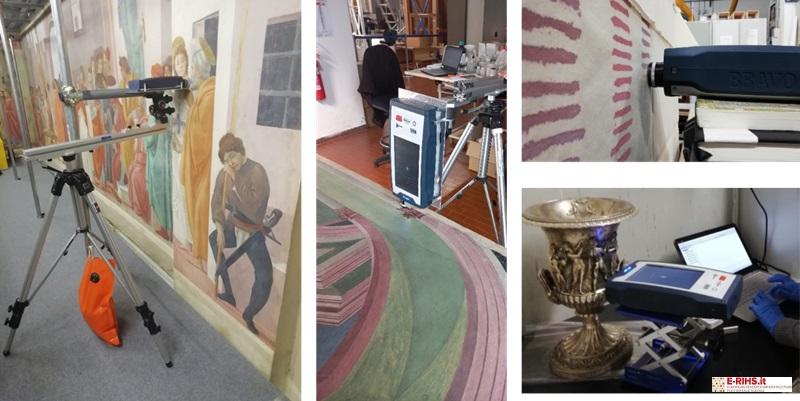
LABORATORY: CNR INO
NAME OF THE INSTRUMENT
SSE. Portable SSETM Raman
Sequentially shifted portable Raman spectroscopy with 785 and 852 nm laser excitation optimized for fluorescence removal. (SSETM Portable Raman)
GENERAL DESCRIPTION
Raman spectroscopy allows for the non-invasive analysis of materials such as pigments, dyes and binders, and other organic substances, degradation products on pictorial, ceramics, paper, membranous, textile, stone and metal surfaces.
One of the major limitations of Raman spectroscopy is related to molecular fluorescence phenomena which often obscure the Raman signal. The strategy employed in the instrument to overcome this limit is based on the patented Sequentially Shifted Excitation (SSE™) technology, capable of returning spectra free from the fluorescence component.
TECHNICAL DESCRIPTION
The portable Raman instrument under the trade name Bravo was developed by Bruker Optics to generate fluorescence-free Raman spectra using the patented Sequentially Shifted Excitation (SSE™) technology. The Bravo portable Raman is equipped with two temperature-controlled diode lasers (DuoLaser.TM, 785 nm and 852 nm) detected by different areas of the CCD with a spatial resolution of 10-12 cm-1The two lasers impinge on the sample sequentially in each measurement covering an extended spectral range from 170 to 3200 cm-1 (wider spectral range than conventional portable Raman spectrometers). The spectra are acquired in two sequential steps: from 170 to 2000 cm-1 and from 2000 to 3200 cm-1using lasers at 852 nm and 785 nm, respectively. Each laser is shifted three times based on a small temperature variation, consequently we will have 3 raw spectra raws. 6 cm-1 for each laser, for a total of 6 raws.The algorithm returns a spectrum processed in the entire spectral range (170-3200 cm-1without the fluorescence component. The acquisition times and the accumulations can be chosen by the operator, or it is possible to carry out a measurement with the conditions of automatic measurements. The spot examined is 500x100 microns. The instrument is compact (30 cm x 13 cm x 5 cm) and is usually placed on a pantograph to allow vertical movement of the spectrometer. In addition, the instrument can be placed on a tripod-mounted platform to increase the mobility of the instrument and to tilt it in different directions. Both objects and materials (e.g. pigments) closed in containers (e.g. glass vials, plastic) can be measured, without resorting to the extraction of the material.
Referent:
Jana Striova jana.striova@cnr.it
